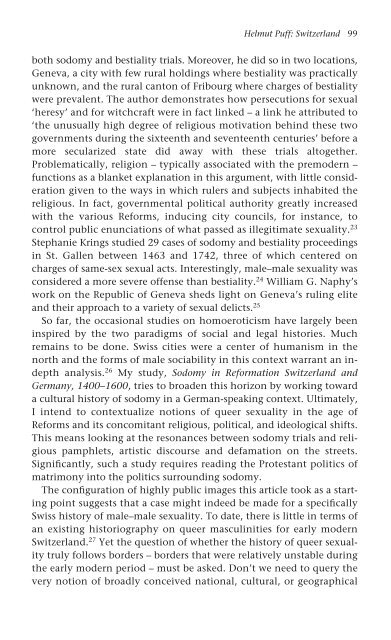queer masculinities
queer masculinities
queer masculinities
You also want an ePaper? Increase the reach of your titles
YUMPU automatically turns print PDFs into web optimized ePapers that Google loves.
Helmut Puff: Switzerland 99<br />
both sodomy and bestiality trials. Moreover, he did so in two locations,<br />
Geneva, a city with few rural holdings where bestiality was practically<br />
unknown, and the rural canton of Fribourg where charges of bestiality<br />
were prevalent. The author demonstrates how persecutions for sexual<br />
‘heresy’ and for witchcraft were in fact linked – a link he attributed to<br />
‘the unusually high degree of religious motivation behind these two<br />
governments during the sixteenth and seventeenth centuries’ before a<br />
more secularized state did away with these trials altogether.<br />
Problematically, religion – typically associated with the premodern –<br />
functions as a blanket explanation in this argument, with little consideration<br />
given to the ways in which rulers and subjects inhabited the<br />
religious. In fact, governmental political authority greatly increased<br />
with the various Reforms, inducing city councils, for instance, to<br />
control public enunciations of what passed as illegitimate sexuality. 23<br />
Stephanie Krings studied 29 cases of sodomy and bestiality proceedings<br />
in St. Gallen between 1463 and 1742, three of which centered on<br />
charges of same-sex sexual acts. Interestingly, male–male sexuality was<br />
considered a more severe offense than bestiality. 24 William G. Naphy’s<br />
work on the Republic of Geneva sheds light on Geneva’s ruling elite<br />
and their approach to a variety of sexual delicts. 25<br />
So far, the occasional studies on homoeroticism have largely been<br />
inspired by the two paradigms of social and legal histories. Much<br />
remains to be done. Swiss cities were a center of humanism in the<br />
north and the forms of male sociability in this context warrant an indepth<br />
analysis. 26 My study, Sodomy in Reformation Switzerland and<br />
Germany, 1400–1600, tries to broaden this horizon by working toward<br />
a cultural history of sodomy in a German-speaking context. Ultimately,<br />
I intend to contextualize notions of <strong>queer</strong> sexuality in the age of<br />
Reforms and its concomitant religious, political, and ideological shifts.<br />
This means looking at the resonances between sodomy trials and religious<br />
pamphlets, artistic discourse and defamation on the streets.<br />
Significantly, such a study requires reading the Protestant politics of<br />
matrimony into the politics surrounding sodomy.<br />
The configuration of highly public images this article took as a starting<br />
point suggests that a case might indeed be made for a specifically<br />
Swiss history of male–male sexuality. To date, there is little in terms of<br />
an existing historiography on <strong>queer</strong> <strong>masculinities</strong> for early modern<br />
Switzerland. 27 Yet the question of whether the history of <strong>queer</strong> sexuality<br />
truly follows borders – borders that were relatively unstable during<br />
the early modern period – must be asked. Don’t we need to query the<br />
very notion of broadly conceived national, cultural, or geographical


